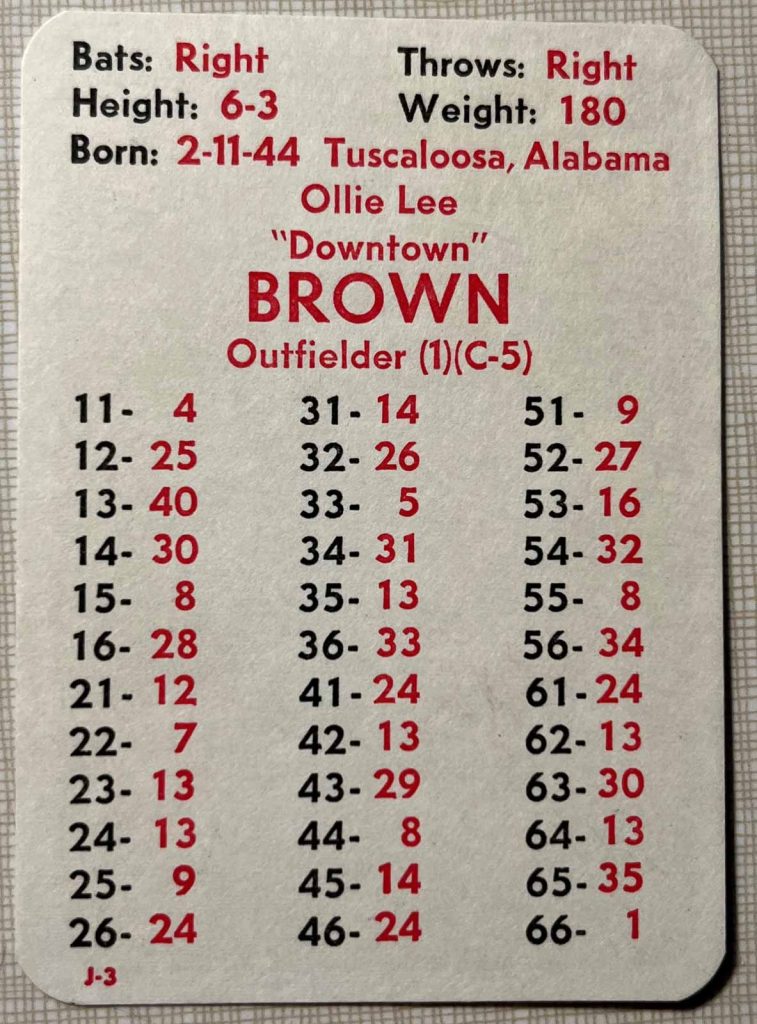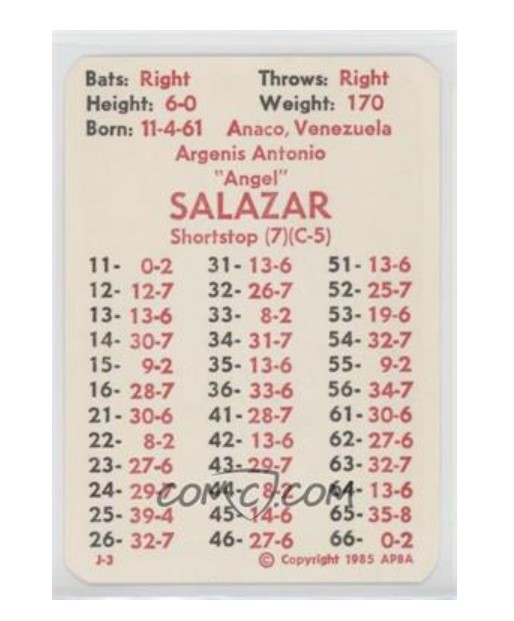Alan Hobbs who contributed to this week’s Monster card, also asked me a question regarding Ollie Brown’s 1974 card and the defensive ratings he was given by the APBA card makers.
It got me thinking so I looked into it.
Here’s Alan’s question:
I am writing because I came across an oddity I thought you would be interested in. I was perusing my 1974 cards and stumbled upon Ollie Brown of the Astros and Phillies. My initial interest in him was because, of all things, he is buried in the same cemetery as my parents, and his brother played football for USC in the 1960s.
Anyway, I looked at his card and he was given a C-5 catcher rating, and I was curious as to why his rating would be so low (a lot of errors, passed balls, etc.). And then I learned something that I had to share with you: Ollie Brown did not have a single appearance as a catcher in his entire major league career.
So why the catcher rating? Could this be an error card? Have you ever come across anything like this?
My take on it
I’ll answer the last question first. Yes, I have run across something along these lines. I was racking my brain for an example and came up with “1984 Luis Salazar”.
Well, I was mostly right.
KC’s Angel Salazar (no relation to to Luis to my knowledge) is in a similar situation as 1974 Ollie Brown. Despite never playing a game behind the plate in his whole career let alone 1984, he was rated as a C-5 on his 1984 APBA card.
I suspect there are probably many more. If you have encountered any, leave them in the comments.
Why did APBA do this?
Why would APBA put a position on a player’s card when he didn’t even play that position… even for his whole career in some cases?
Well in my opinion, basically APBA did what they had to do.
Before 2012, APBA only included 20 player cards per team unless you purchased the XB (or “extra card“) set. With those 20 cards per team, APBA had to make sure all positions were covered on the team. In addition, every team had to have an adequate number of starting pitchers and relievers. Like real life baseball, sometimes someone has to get cut. If one bought the set with 20 cards per team and didn’t buy the XBs, APBA wanted to make sure there was a backup for each position.
Looking at both of these scenarios, the 1984 Salazar case is pretty cut and dry. The Expos’ catcher was Gary Carter and in 1984 he played in 159 games. As for 1974 Downtown Brown, his case is less obvious. The Phillies’ first-string catcher Bob Boone played in 146 games. That’s a lot to be sure it’s not the Hundley-esque number that Carter had. The issue here is that the balance of caught games were split by two different catchers, Larry Cox (30g, 53ab) and Jim Essian (17g, 20ab). I warrant APBA didn’t feel either’s playing time didn’t warrant a “regular” APBA card.
Now, let’s not fool ourselves. Gary Carter did not catch 159 complete games and he did have a backup. His name was Bobby Ramos and he caught at least 15 complete games behind the plate. If anyone was looking for realism, they could have bought the XB set which included Ramos.
APBA solves this problem in 2012
From 2012 going forward, the APBA Company discontinued the “XB set” concept and each new set includes 30 players/cards per team. This does come at a cost to the customer as APBA was essentially incorporating the XB set into the regular one. I’m sure this boosted revenues for the Company but honestly, it was a lot simpler too. This move gave replayers plenty of room on the roster for players like Ramos, Cox or Essian. And no need for APBA to give “wrong” positions on a players’ card.
For those picking up used sets online from the 70s and the 80s, do your best to get the XB set if you can. This is especially helpful if you’re doing a season replay. Poor Gary Carter will get worn out by season’s end.
Final notes
A few final comments regarding Alan’s original question…
- This is mostly a supposition on my part and not official APBA policy. That said, I think I’m on track on why it was done.
- I do think the choice of players was interesting especially in Salazar’s case. For his career, Salazar was a pure middle infielder with just a handful of games at second and third.
- I would wager that any other such players who have not played a position they are rated for would be would be rated the absolute lowest fielding rating possible.
- On a slightly different tangent, the new sets from 2012 and on had other features too. Most notably, they included Master Game symbols printed on the cards themselves (rather than a separate booklet).
Thanks for an excellent question, Alan!






Thank you Tom for the great insight! What you wrote makes a lot of sense, especially given that the XB cards did fill that position for catcher with Cox.
My curiosity is why APBA would bother to do this at all, given that they already address the need for non-position players on the Bases Empty old board, with ratings for each position in that circumstance (catcher is a 4).
BTW, Boone had a J-1 rating that year, so it definitely could have come up, if only for a few games.
I’ll be on the lookout for other oddities. Love the blog!
-Alan
Hi Alan,
I think APBA just felt the need to be consistent. Every position needed a backup without resorting to that rule. Again, that’s just my feeling.
thanks again!
The Kid must have been a real pain for the company; Rodney Scott was the C-5 in 1980.
Hi Andrew, Good catch! I think I remember that card.
Tom
Great post. Brown did a bit of pitching in his minor league career, so maybe they thought he was better positioned (pun) to don the mask in the 20-card set in an emergency.
Salazar caught at least an inning as an 18-year-old in the minors. :)
Todd R.
Thanks, Todd! Nice bit of research! Sounds like the APBA card makers put some thought into this.
Tom
Thanks Tom (and love the site BTW) – given how many paper-based sources it must have taken to find this data in those days, I presume Seitz deep-dove into SI publications, et al, to dig it up. APBA brings that amazing sense of place and time that makes me smile all of the time.
Todd R.
I shudder to think of the work the card makers went through pre-Internet.
Sort of related… I seem to remember the Company enlisted the help of fans as “scouts” for help rating fielders. I think my current commish was an APBA scout for the Cardinals.
I wonder if in those days if APBA consulted with the MLB teams? Most teams have an “emergency catcher” when the starter or back up is injured and for whatever reason they have to put in a guy who does not catch.
The rating of a non-catcher would have been helpful in my current replay. The 1908 A’s only have 2 catchers. I bought the set at a tournament, so I thought either I was missing one, or it was in the wrong envelope. It wasn’t. They did not have an extra player set of any kind for this set.
So, I went to Baseball Reference and in the actual season they used 6. Of those 6, in September Ossee Schrecongost was traded to the White Sox, Syd Smith was traded to the Browns.
Of the remaining 4 Ben Egan only appeared in 2 games and was not carded. Bert Blue only appeared in 6 games and was not carded. Jack Lapp only appeared in 13 games, but with 43 at bats did receive a card.
Schrecongost and Smith removed a combined total of 117 games and 463 at bats from the roster.
So, I used all of Lapp’s games and decided as going away present of sorts to Doc Powers, who died just a few weeks into the real 1909 season. His card is just a notch above “terrible Tuesday” level, so it’s not like the A’s are getting any benefit from it other than someone to fill the 8 spot in the lineup.